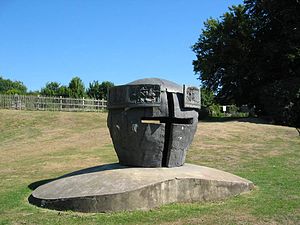Battle of Lewes
| Battle of Lewes | |||||||
|---|---|---|---|---|---|---|---|
| Part of Second Barons' War | |||||||
 Plan of the Battle of Lewes | |||||||
| |||||||
| Belligerents | |||||||
| Baronial forces | Royal forces | ||||||
| Commanders and leaders | |||||||
|
Simon de Montfort Gilbert de Clare |
Henry III Prince Edward Richard of Cornwall | ||||||
| Strength | |||||||
| c. 10,000 | c. 5,000 | ||||||

The Battle of Lewes was one of two main battles of the conflict known as the Second Barons' War. It took place at Lewes in Sussex, on May 14, 1264. It marked the high point of the career of Simon de Montfort, 6th Earl of Leicester, and made him the "uncrowned King of England".
The battle occurred because of the vacillation of King Henry III, who was refusing to honour the terms of the Provisions of Oxford, an agreement he had signed with his barons, led by Montfort, in 1258. The King was encamped at St. Pancras Priory with a force of infantry, but his son, Prince Edward (later King Edward I) commanded the cavalry, at Lewes Castle a mile to the north. A night march enabled Montfort's forces to surprise Prince Edward and take the high ground of the Sussex Downs, overlooking the town of Lewes, in preparation for battle. They wore white crosses as their distinguishing emblem.[1]
The royalist army, perhaps as much as twice the size of Montfort's,[2] was led by Edward on the right and the King's brother Richard of Cornwall on the left, while the King himself commanded the central battalion.[3] Having led his men out from the castle to meet the enemy, Edward gained early success, but unwisely pursued a retreating force to the north, thus sacrificing the chance of overall victory.[4] Meanwhile, Montfort defeated the remainder of the royal army led by the King and Cornwall. On being defeated, Cornwall decided to take refuge in the Priory. He was unable to reach the Priory so he hid in a windmill, where, upon his discovery, he was taunted with cries of "Come down, come down, thou wicked miller!" [5] All three royals were eventually captured, and by imprisoning the King, Montfort became the de facto ruler of England.
The King was forced to sign the so-called Mise of Lewes.[6] Though the document has not survived, it is clear that Henry was forced to accept the Provisions of Oxford, while Prince Edward remained hostage to the barons.[7] This put Montfort in a position of ultimate power, which would last until Prince Edward's escape, and Montfort's subsequent defeat at the Battle of Evesham in August 1265.
Notes
References
- Burne, A. H. (1950, reprint 2002) The Battlefields of England London: Penguin ISBN 0141390778
- Prestwich, Michael (1988) Edward I, London: Methuen London ISBN 0413281507
- Maddicott, J. R. (1994) Simon de Montfort, Cambridge: Cambridge University Press ISBN 0521374936
- Carpenter, D. A. (1996) The reign of Henry III, London: Hambledon ISBN 1852850701
External links
- A map and timeline of the battle
